|
| Beyond
the esplanade
stands the Hall of State, built as a structure to complement the pool
and two buildings. The T-shaped museum currently serves as the home
of the Dallas Historical Society. The organization was founded by
George Dealey, the vice-president and general manager of The Dallas
Morning News, with the help of one hundred members in March 1922.
After receiving its charter from the government, the society focused
on its main goal of preserving local and state history through the
collection of artifacts and literature. It also wanted to broaden
the public's awareness of the rich past using its acquired resources.
The organization originally held its meetings and stored its collections
at one of the many libraries at Southern Methodist University. This
changed in 1938 when the city of Dallas agreed to rent the Hall of
State from the Texas government, then handed the responsibility of
operating the building to the Dallas Historical Society. In 1977,
the rental agreement came to a close when complete ownership of the
facility was given to the city. |
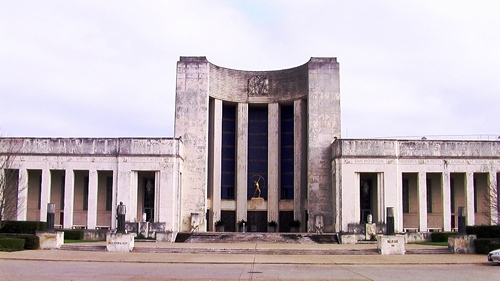 |
Fair
Park - Hall Of State
Photo courtesy Clint Skinner, February 2016 |
| The Hall of
State currently serves as a museum and research facility. Making sure
that the place continues to carry out these functions, the society
has over 8,000 books and 13,000 objects. The collection of artifacts
include blueprints, maps, periodicals, journals, artwork, photographs,
and historical memorabilia. In addition to putting them on display,
the society uses them for educational outreach programs. Schoolchildren
can take tours of the building while adults can use its extensive
library for research or reserve space for a special event. Regardless
of age, people can visit the museum for free. |
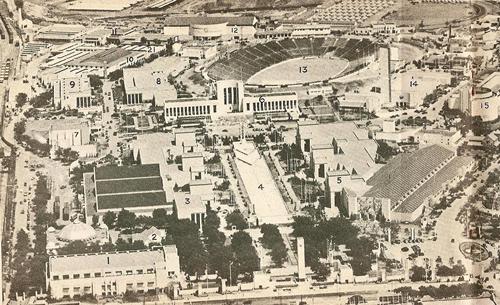 |
The Hall of
State, however, did not begin as a museum. It started as the centerpiece
of the esplanade during the Texas
Centennial Exposition. To emphasize its importance, George Dahl
placed it at the top of the pool and its two neighbors. Construction
began in 1935 and finished in September 1936, three months after the
expo started. The structure would have been ready by the grand opening,
but difficulties with the indoor decoration prevented its availability
to the public. When it opened as the State of Texas Building,
it became the most expensive building in Texas per foot, thanks to
its large price tag of 1.2 million dollars. The limestone structure
was 1,500 foot long and sported a combination of classicism and art
deco. The design of the entire building was done by a Texan named
Donald Barthelme.
Originally from Galveston,
Barthelme attended the Rice Institute in Houston,
but transferred to the University of Pennsylvania to complete his
education. He worked as an architect in Philadelphia after he graduated
in 1930. However, he only stayed there for two years before returning
to Texas. Donald worked on several projects, but his largest endeavor
was the Hall of State. He continued his career of designing and constructing
buildings while serving as a teacher at the University of Houston.
Among his many works were Avion Village in Grand
Prairie, Webb Air Force Base in Big
Spring, and the St. Rose of Lima Church and School in Houston.
In addition to these accomplishments, he designed various schools
in Brazoria County. |
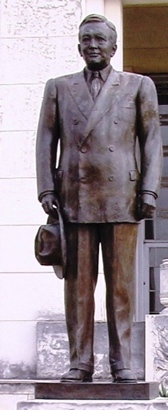 |
Robert L. Thornton
Statue
Photo
courtesy Clint Skinner |
|
Four
lamp posts, two on the left and two on the right, mark the entrance
to the terrace known as the Court of Honor. Each one has
six bronze figures that represent the six nations that have influenced
Texas. Standing in a circle on a concrete base, the hand-crafted
artwork depicts a Spanish Conquistador, French aristocrat, Mexican
general, Texas pioneer, Confederate leader, and American soldier.
After passing these lamp posts, visitors walk along the terrace
toward the main entrance. In the corner of this flat area, a bronze
statue pays tribute to Robert L. Thornton.
The influential mayor was born in 1880 near Hico,
Texas. However, his parents lost their farm and moved to Village
Creek. He spent much of his early childhood picking cotton
while attending school. After graduating from the eighth grade,
Robert began work as a store clerk. He used this money to attend
a business class, then became a traveling salesman in the region.
He tried to start his own business twice, a book store and a mortgage
company, and failed miserably on both accounts. Nevertheless, he
refused to give up. Robert combined his financial resources with
his two brothers-in-laws to form a private banking company in 1916
and called it Stiles, Thornton, and Lund. A year later, the new
enterprise became responsible for the administration of the Dallas
County State Bank. His success in the financial sector led to a
one-year term as the president of the Texas Bankers Association.
Thornton soon expanded his business endeavors. He became vice president
of the Tex-O-Kan Flour Mills Company and United Fidelity Life Insurance
Company. He also served as a director for Dallas Power and Light,
Lone Star Steel, Southwestern Life Insurance, the Dallas Hotel Company,
and the Weatherford, Mineral Wells and Northwestern Railway.
In 1928, he organized a nonprofit organization called Industrial
Dallas, Inc. to bring industry to the city. He became the president
of the Dallas Chamber of Commerce in 1933 and remained there for
three years. Robert played an important part during this tenure
in making sure that Dallas became the
location for the centennial celebration. After the grand event,
he left the chamber and served as a director of the upcoming Pan-American
Exposition. In 1945, he served as the president of the State Fair
of Texas for fifteen years and received credit for making it the
largest one in America. Robert Thornton became the city's mayor
in 1953. During his eight years in office, he expanded Love Field
Airport and built a new city hall, library, and auditorium. He also
helped in making the Forney Dam a reality, providing a new water
resource in the process. Thornton died three years after he stepped
down from his mayoral office. His deep commitment and many achievements
led the local press to call him Mr. Dallas. In recognition for his
service, the city council named two highways after the man who started
life as a cotton farm.
|
|
Leaving
the Court of Honor, visitors traverse the semi-circular Portico
Tejas before entering the building. Concrete benches along the left
and right wings allow people to rest near the art deco chandeliers.
On the exterior of the wings, the names of historic figures in the
state's past are carved in a frieze that wraps around the entire
building. Each name is accompanied by a native Texas plant. Altogether,
there are fifty-nine Texans represented on the frieze.
|
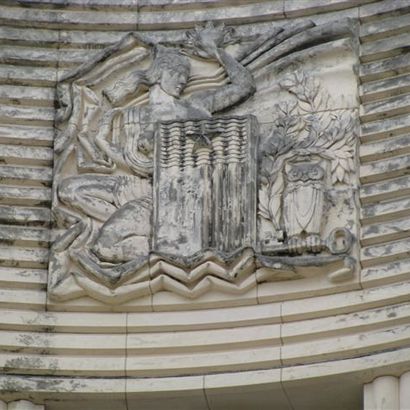 |
|
At
the entrance itself, there are four seventy-six-foot pillars that
reach a carving called The Symbolic Seal of Texas. Designed
by Barthelme and sculpted by local artist Henry Lee Gibson, the
bas relief depicts a woman behind a shield. The woman is called
the Lady of Texas and the shield protecting her has the state
flag's design on it. The lady holds a fire representing patriotism.
Perched next to her, an owl symbolizes wisdom and holds a key that
stands for prosperity and progress. Pecan leaves belonging to the
official state tree decorate the background.
|
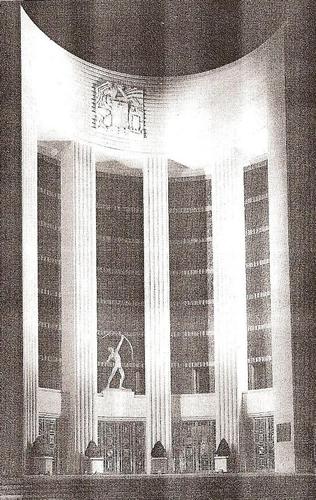 |
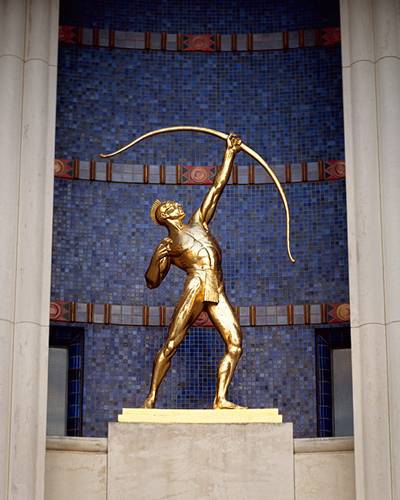 |
The
limestone columns leading to the bas relief are placed in front of
a mosaic layer of blue tiles representing a field of bluebonnets.
In the middle, an eleven-foot tall statue of a Native American stands
above the main door. Made out of bronze and covered in gold leaf,
Tejas Warrior presents the role that Indians played in Texas
history. The arrowless bow that the warrior holds in his hands symbolizes
peace. The statue greeting visitors was the work of sculptor Allie
Victoria Tennant.
Born in Missouri during 1898, Allie made her first sculpture when
she was only eight years old. After spending most of her life in Dallas,
she moved to New York City to study at the Art Students League. Tennant
returned to Dallas and began making statues,
fountain features, portrait busts, and other forms of sculptural art
using bronze as her preferred medium. In addition to her work at the
Hall of State, Allie Tennant also provided her skills for the Dallas
Aquarium at Fair Park, the James Butler Bonham Memorial in Bonham,
and the Antonio Navarro Memorial in Corsicana.
She later wrote columns for the Dallas Morning News and taught at
the Dallas Art Institute.
Below
the statue Tejas Warrior, five double-doors made of bronze lead to
the building's interior. They are decorated with symbols of agriculture
and industry. Farming is represented by wheat sheaves and cotton plants,
the timber industry is symbolized by saw blades and pine cones, the
oil industry is presented through derricks, and ranching is depicted
through cattle, horses, lariats, and hooves. The designs of these
doors were made by Barthelme. |
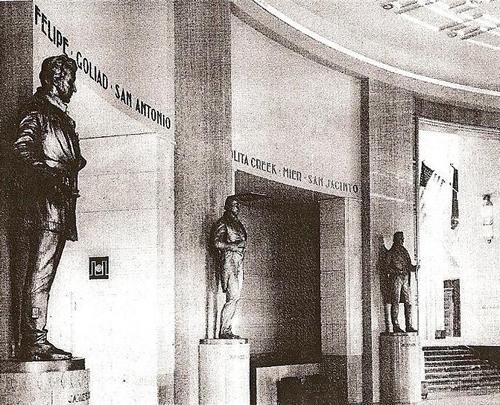 |
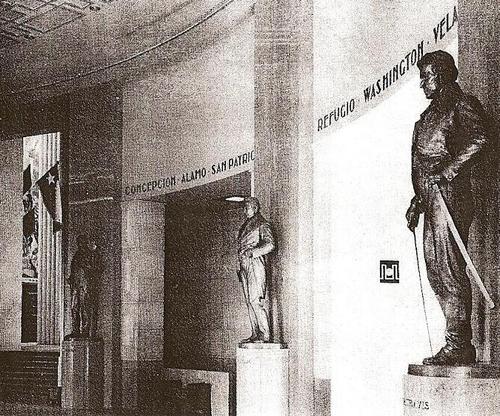 |
Bronze
statues in the Hall of Heroes
From "Monuments Commemorating the Centenary of Texas Independence",
State of Texas, 1938
Courtesy Sarah
Reveley |
|
The
five doors of the main entrance lead into the Hall of Heroes,
a long corridor with a marble floor. A frieze along the top of the
wall provides the names of battles which occurred during the Texas
Revolution. There are also two plaques, one paying tribute to those
who died at the Alamo
and another commemorating the Battle
of San Jacinto. The biggest feature of the hall, however, is
the life-sized bronze statues of six prominent Texans. Lined along
the semi-circular corridor, they honor the memories of Stephen F.
Austin, Sam Houston,
Mirabeau
B. Lamar, James Fannin, Thomas Rusk, and William B. Travis.
These statues were the work of Italian artist Pompeo
Luigi Coppini.
Pompeo began his artist career at the age of ten by making ceramic
whistles shaped like a horse. He then used his skills by making
imitations of artistic masterpieces and selling them to tourists.
In 1896, he moved to New York and obtained a job at a wax museum.
He moved to San Antonio
in 1901 and stayed there for the next fifteen years. It was during
this time that Pompeo began building his reputation as a sculptor
through various projects. In 1934, he was hired to design the Texas
Centennial half dollar before receiving a contract to make the Hall
of Heroes statues. In addition to his work for the exposition, he
was also responsible for the Monument
to Terry's Texas Rangers and the Littlefield
Memorial Fountain in Austin,
the Sam
Houston Grave Monument in Huntsville,
the Cenotaph to
the Heroes of the Alamo in San
Antonio, and the Come and Take It Monument in Gonzales.
|
|
At
both ends of the Hall of Heroes, there is a chamber divided
into two rooms. Each room is dedicated to a different area of the
state and covers at least 1,300 square feet. The East Texas
and West Texas rooms lie to the left of the hall. Used to
display relics and artwork from the past, the East Texas Room has
walls made out of the wood from dark gum trees.
Although the exhibits may change from time to time, two pieces of
artwork remain the same. Artist Olin Travis, the co-founder
of the Dallas Art Institute, was hired to paint a pair of murals
to depict the Eastern region of the Lone Star State before and after
the great oil boom. The first mural shows a pine forest being harvested
for the lumber industry while the second one displays oil derricks
among a cloud of smoke with a large, urban city in the background.
Two glass doors in the back lead to the West Texas Room. It has
wooden ceiling beams that have two chandeliers hanging from them.
Below the beams, the tile floor carries a cactus motif. Three of
the walls resemble an adobe style, but the fourth one is made out
of cowhide. In front of the cowhide stands a wooden cowboy figure
made by local sculptor Dorothy Austin. Tiles along the adobe
walls show an Indian, pioneer, wrangler, sheriff, sheep herder,
and guitar player. A tabletop near the entrance displays a bronze
bust of David Crockett which was donated by artist William Easley.
Above the cowhide, there is a mural of a cowboy surrounded by ranchers
and cattle. On the other side of the room, another mural depicts
three people riding a horse wagon. Both of the paintings were the
work of Tom Lea, a resident of El
Paso. Although he made plenty of memorable pieces, Tom became
famous for working as a war artist and correspondent for Life Magazine.
The most popular paintings were the ones he produced while covering
the western part of the Pacific, especially those dealing with the
Battle of Peleliu.
|
|
From
1987 to 1989, the Hall of State underwent some remodeling. A part
of the process was the transformation of the West Room from an exhibition
chamber into a library for researchers. When the project was completed,
officials named the place the George B. Dealey Library. It
currently has 2.5 million documents, 3,000 photographs, 14,000 books,
and 3,000 periodicals. An appointment made in advance is the only
way to take advantage of the resources or enjoy the artwork contained
within its walls.
The North Texas and South Texas rooms are located
to the right of the hall. Like the other chamber, the area is divided
into two rooms that display historic exhibits. Photographs of the
state's northern region taken by Polly Smith, the one responsible
for taking pictures for the exposition's marketing campaign, decorate
the sides of the room. Above the entrance inside the chamber, there
is a fresco painted on the wall's plaster. A local citizen named
Arthur Starr Niendorff used his talents to make the artwork, which
depicts a character named Old Man Texas. First imagined by John
Knott, an editorial cartoonist at the Dallas Morning News, the old
man is shown wrapping his arms around Dallas
on one side and Fort
Worth on the other with a family in the middle. The character
is surrounded by objects representing different things. A farm symbolizes
the area's agricultural industry, a plane and train stand as icons
of transportation, a vault and ticker tape machine represent the
financial and business aspects of the region respectively, the books
in front of the vault stress the importance of education, and a
turbine symbolizes the manufacturing industry.
Along the walls between the windows of the South Texas Room, there
are eight painted figures representing life in the region. They
include a farmer, a grapefruit picker, a dock-worker, a priest,
a cotton picker, and a woman wearing a swimsuit. A craftsman named
Lynn Ford made two wood carvings representing history and romance,
both located above the entryway. On the other side, a mural painted
by James Owen Mahoney, Jr. shows a woman standing for the southern
region of the state with her surroundings symbolizing the riches
of the land and sea.
|
|
The
Hall of Six Flags, more commonly known as the Great Hall,
is the largest room in the building. Located along the center of
the Hall of Heroes across from the main entrance, it covers 6,365
square feet and reaches a height of forty-six feet. The six flags
that flew over Texas hang from the inner walls next to the entrance,
three on the left side and three on the right. Above the entrance
is a quote from Mirabeau B. Lamar that reads, "And well may we be
proud to see our national standard float side by side in the breeze
with Star Spangled Banner of the Fatherland."
The ceiling is painted a variety of colors and looks like a carpet.
In addition, an artist from Yale University named George Davidson
hand-stenciled several patterns and four icons on the surface. The
icons were Aztec-style representations of an armadillo, an abstract
symbolizing land, an abstract symbolizing the sea, and a roadrunner
with a rattlesnake in its beak. Ten chandeliers hang from this ceiling
and helps bring illumination to the room. The floor below is made
out of green Vermont marble and has four stripes of San Saba stone
that begin at the entrance and end at the back. The floor also contains
tiles that represent wildlife found in the state. They include the
tarpon, Texas horned lizard, javelina, black-tailed prairie dog,
northern mockingbird, golden eagle, turkey, giant roadrunner, black-tailed
jackrabbit, nine-banded armadillo, western diamondback rattlesnake,
and American alligator. At the head of each tile is a high-back
chair that sits in front of a pillar made from limestone. Behind
the pillars along the walls, silver doors remain locked to the public.
One of them is replaced by a marble slab with a bronze medallion
that honors the memory of George B. Dealey.
On the back wall lies a large gold bas-relief covered with burnished
gold leaf medallion that has a diameter of twelve feet. Shaped like
a medallion, it was made by Joseph Renier, a professor at Yale University.
The artwork has a large, five-pointed star in the middle. In each
area between the points, there is a woman who represents one of
the six flags over Texas. All of them have a shield with the appropriate
symbols of the nation being honored. Anson
Jones, one of the presidents of the Texas Republic, has one
of his many quotes placed above the medallion. It reads, "The Lone
Star of Texas has passed on and become fixed in that glorious constellation
which all freemen and lovers of freedom must reverence and adore
- the American Union."
|
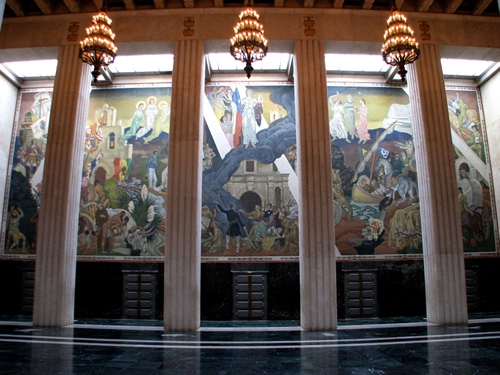 |
History of Texas
mural on the left
Photo courtesy Quester Mark, March 2008* |
The neighboring
walls of the gold medallion showcase two murals painted by Eugene
Francis Savage. Born in Covington, Indiana, the artist spent
his time studying in Chicago and Rome. He finished his education
at Yale University and later served as a professor there. Savage
became well-known for the art he made during his tenure working
for the Works Progress Administration. In addition to the ones he
painted at the Hall of State, he produced murals depicting the Hawaiian
and Seminole lifestyles. After World
War II ended, he installed a glass mosaic depicting the events
of Operation Dragoon, the Allied landing of Southern France that
expanded into a campaign through Germany. Savage was also responsible
for the Alma Mater mural at the Sterling Memorial Library of Yale
University.
When Eugene Savage received his contract regarding the Hall of State,
officials instructed him to make two murals depicting the history
of Texas. He followed their orders in an untraditional way by refusing
to directly paint them on the walls. Instead, he performed the task
on a canvas, then placed them on the hall surfaces. With the help
of four artists, he was able to finish the project in five months.
Each of the two murals is thirty feet long and eighty feet wide.
The one on the left tells the story of Texas from the Spanish explorers
known as Conquistadors to the Battle
of San Jacinto. Instead of doing it chronologically, however,
the tale starts on the different ends and works its way to the center.
The mural on the right depicts Texas during its period of statehood.
The left side shows various historical figures, three women representing
the restoration of the Union after the Civil War, and the agricultural
aspects of the state. The right side displays the various forms
of industry like lumber and oil. At the center of the painting,
the importance of education and its influence on the future is symbolized
through a woman holding a torch in front of a group of children.
|
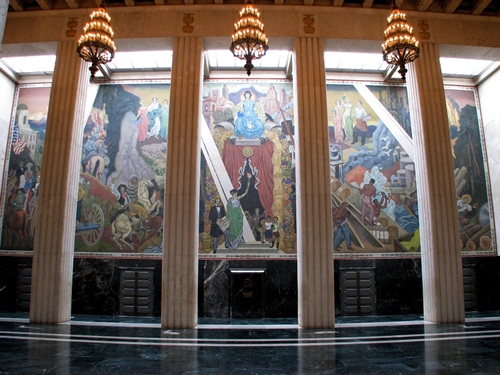 |
History
of Texas mural on the right
Photo courtesy Quester Mark, March 2008* |
| The
offices of the Dallas Historical Society and its archival storage
are located on the lower lever. At one time, it served as the location
of the American Museum of Miniature Arts, which exhibited a wide range
of house and furniture models of houses. Unfortunately, what happened
to the collection remains a mystery. The other main feature of the
floor is the Margaret and Al Hill Auditorium, named after the former
director of the DHS and her husband. She also played an important
part in the establishment of the East Texas Oil Field Museum in Kilgore,
Texas. |
Statue of Liberty
Photo courtesy Clint Skinner, February 2016 |
| A
miniature version of the Statue of Liberty stands on the left side
of the Hall of State's Court of Honor. In 1950, it was given to Fair
Park by the Boy Scouts of America to celebrate the organization's
fortieth anniversary. J. P. Whitaker, the Scout Commissioner of the
Kansas City Area Council, came up with the idea. It became so popular,
over two hundred were produced and sent to locations throughout thirty-nine
of the states. The copper statues stood at the height of eight feet
and four inches, weighed 290 pounds, made by the Friedley-Voshardt
Company, and carried a price tag of 350 dollars. |
| Prospero
Bernardi Monument |
Prospero Bernardi
Monument
Photo courtesy Clint Skinner, February 2016 |
Located
to the right of the Court of Honor, a granite pedastal with a bust
of Prospero Bernardi on top of it pays tribute to a hero of the Texas
Revolution. The Italian immigrated to America then sailed to New Orleans,
where he joined a group of volunteers headed to Texas. He arrived
in 1836 and immediately joined the struggle for independence. He managed
to gain lots of prestige, thanks to his bravery and skills at the
Battle of San
Jacinto. Bernardi remained in the Texas Army until he was injured
during a conflict at Galveston
the following year. According to the testimony of two soldiers he
died in 1838.
The statue commemorating the valiant soldier was given to the Texas
Centennial Exposition from the Italian communities living in the state.
Sculpted by Pompeo
Coppini, the bust was publicly unveiled by Governor Allred on
October 12, 1936 in the presence of an Italian diplomat currently
serving Benito Mussolini. Commendatore Bartolomeo Migone used the
opportunity to thank the governor for honoring the role of Italians
played in the history of the Lone Star State. |
Berlin Bear
Photo courtesy Clint Skinner, February 2016 |
|
Located
on the right side of the far reaches of the lawn separating the
Hall of State and Tower Building, there is a small, bronze statue
of a bear reaching a height of two feet and six inches. Standing
on top of a concrete pillar, it was a gift from the citizens of
Berlin. The beleaguered city had been split into four zones, one
belonging to the Soviet Union and the other three to Britain, France,
and America. The triumvirate succeeded in its currency reforms in
the region that would soon be called West Germany. When the three
nations tried to extend these policies into West Berlin during 1948,
the Soviets erected the Berlin Blockade to stop the ability to travel
to the allied portion of the city. The citizens were in dire need
of food and supplies, forcing the United States and its two companions
to conduct airlifts. The Soviet Union did not interfere with these
efforts because the government feared such actions would lead to
a full-scale war. The operations continued until 1949 when the Soviets
decided to end the blockade.
To show their appreciated the appreciation for sending food during
that time of need, the citizens of West Berlin gave the 84-pound
sculpture to the city of Dallas in 1970. Sculptor Hildebert Kliem,
responsible for the restoration of many historical buildings, made
the statue. It was formally dedicated during the state fair on what
was called German Day in the presence of Horst Grabert, the secretary
of federal affairs for Berlin.
*Author's
Note: All the pictures that are not mine are either public domain
or creative commons. I provided the photographer's name.
|
References:
1.Bigtex.com
2.Dallashistory.org
3.Dallas Morning News Archives
4.Fairpark.org
5.Slate, John H. Historic Dallas Parks. Arcadia Publishing, 2010.
6.Tshaonline.org
7.Watermelon-kid.com
8.Wikipedia.org
8.Winters, Willis Cecil. Fair Park. Arcadia Publishing, 2010. |
|
|
| Texas
Escapes, in its purpose to preserve historic, endangered and vanishing
Texas, asks that anyone wishing to share their local history, stories,
landmarks and vintage or recent photos, please contact
us. |
|
|